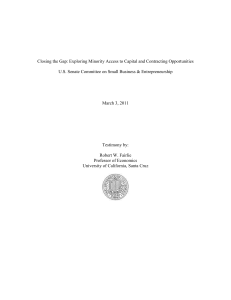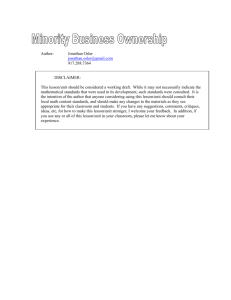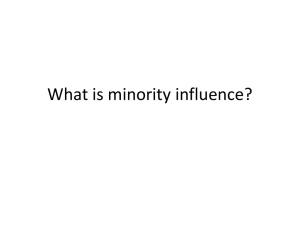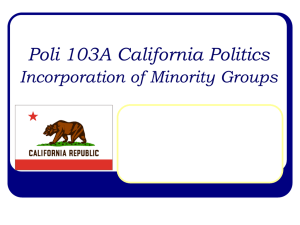Assessing Access: Obstacles and Opportunities for Minority Small
advertisement
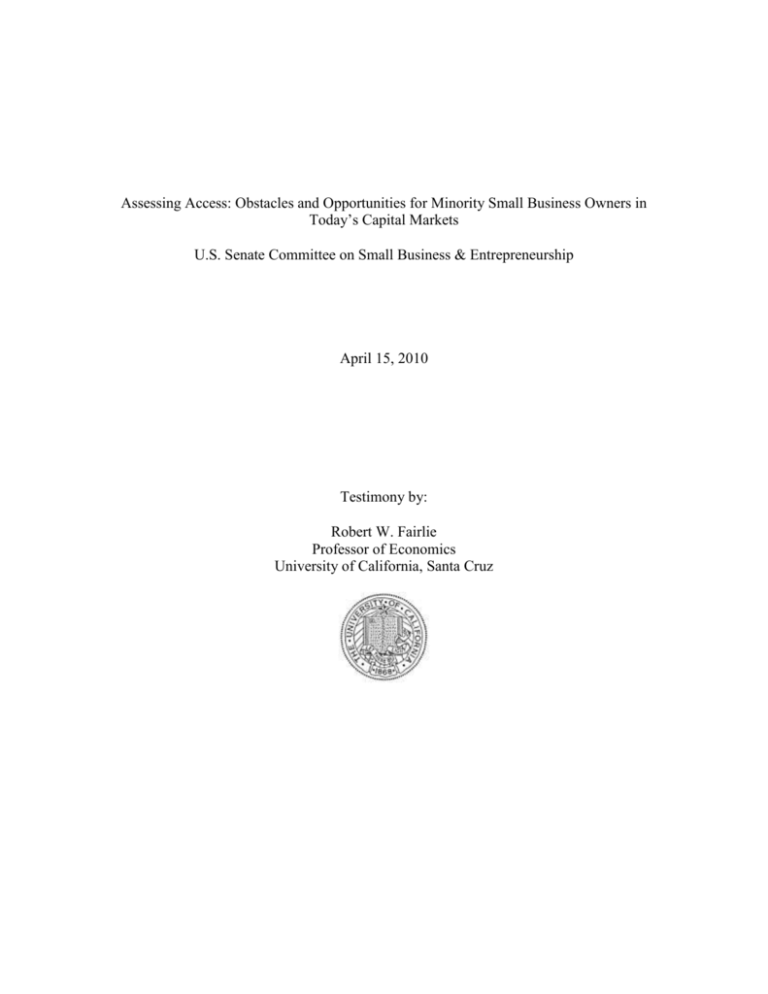
Assessing Access: Obstacles and Opportunities for Minority Small Business Owners in Today’s Capital Markets U.S. Senate Committee on Small Business & Entrepreneurship April 15, 2010 Testimony by: Robert W. Fairlie Professor of Economics University of California, Santa Cruz Thank you, Chair Landrieu, Ranking member Snowe, and members of the Committee. It is an honor to testify before you on the important topic of access to capital for minority businesses. I am a Professor of Economics at the University of California, Santa Cruz and have studied small businesses and entrepreneurs for almost 20 years. I have been asked to briefly discuss the findings from my research on the topic.1 Financial Crisis and Recession The U.S. Economy has lost more than 8 million jobs since the start of the recession in December 2007. The national unemployment rate is hovering around 10 percent, which is twice as high as it was only a couple of years ago. Small businesses have been hit extremely hard by the downturn. The rate of businesses filing for bankruptcies in the United States increased by more than 150 percent from the rate in mid 2007. The financial crisis has certainly contributed to the rapid increase in business closings. An extensive body of research shows that access to financial capital is paramount to the success of small businesses. Although downward trends have been slowing, all indicators continue to reveal extremely tight credit conditions for entrepreneurs. In its latest survey of lending officers, the Federal Reserve reports that commercial banks "have yet to unwind the considerable tightening that has occurred over the past two years."2 Home equity, often used to help finance business starts, has also declined substantially because of the drop in housing prices. The State of Minority-Owned Businesses Minority-owned businesses are being hit especially hard by the current financial crisis and recession. Extensive research of mine and others indicates that minority businesses face substantial barriers to entry, growth and survival even in more favorable economic conditions. Minority firms are more vulnerable because they are generally smaller and have fewer resources to draw on in difficult economic times. The average minorityowned business has revenues of $170,000 per year, which is only 38 percent of the level for non-minority businesses. Minority owned firms also hire fewer employees and have lower profit levels. Barriers Faced by Minority-Owned Businesses Of the many factors responsible for these disparities in business performance, access to financial capital is perhaps the most important. A large number of studies show that limited access to capital hinders the formation and growth of minority-owned businesses. One of the major roots of the problem is the extremely high level of wealth inequality 1 The findings presented here are summarized from Robert Fairlie and Alicia Robb, Race and Entrepreneurial Success: Black-, Asian-, and White-Owned Businesses in the United States Cambridge: MIT Press (2008). Robert Fairlie and Alicia Robb, Disparities in Capital Access between Minority and Non-Minority-Owned Businesses: The Troubling Reality of Capital Limitations Faced by MBEs., U.S. Department of Commerce, Minority Business Development Agency, January 2010. 2 Board of Governors of the Federal Reserve System, The January 2010 Senior Loan Officer Opinion Survey on Bank Lending Practices (2010). found between minorities and non-minorities. Estimates of median net worth from the Census Bureau are displayed in Figure 1. Figure 1: Median Household Wealth and Income U.S. Census Bureau, 2004, 2008 $100,000 $87,056 $75,000 $55,530 Non-Minority African-American Latino $50,000 $37,913 $34,218 $25,000 $5,446 $7,950 $0 Median Wealth Median Income Half of all African-American families have less than $5,500 in total wealth, and half of all Latino families have less than $8,000. These levels of wealth are one-eleventh to onesixteenth the levels of wealth held by non-minorities ($87,000). These disparities in wealth are also substantially larger than disparities in income. African-American and Latino income levels are 60 to 70 percent of non-minority levels. These low levels of wealth among minorities translate into fewer startups and undercapitalized businesses because an entrepreneur's wealth is often invested directly in the business or used as collateral to obtain business loans. Entrepreneurs are also frequently required by investors to invest their own money in the business as an incentive. Further limiting the ability of minority entrepreneurs to obtain financial capital is racial discrimination in lending practices. Several studies have examined whether minority firms face discrimination in obtaining business loans.3 The main finding from this 3 David G. Blanchflower, P. Levine, and D. Zimmerman, "Discrimination in the Small Business Credit Market," Review of Economics and Statistics 85, no. 4 (2003): 930-943. Ken Cavalluzzo, Linda Cavalluzzo, and John Wolken. “Competition, Small Business Financing, and Discrimination: Evidence from a New Survey,” Journal of Business 75, no. 4 (2002): 641-679. Ken Cavalluzzo and John Wolken, "Small Business Loan Turndowns, Personal Wealth and Discrimination," Journal of Business 78, no. 6 (2005): 2153-2177. Lloyd Blanchard, John Yinger and Bo Zhao, "Do Credit Market Barriers Exist for Minority and Women Entrepreneurs?" Syracuse University Working Paper (2004). Susan Coleman, "The Borrowing Experience of Black and Hispanic-Owned Small Firms: Evidence from the 1998 Survey of Small Business Finances," The Academy of Entrepreneurship Journal 8, no. 1 (2002): 1-20. Susan Coleman, "Borrowing Patterns for Small Firms: A Comparison by Race and Ethnicity." The Journal of Entrepreneurial Finance & Business Ventures 7, no. 3 (2003): 87-108. K. Mitchell and D.K. Pearce, Availability of Financing to Small Firms using the Survey of Small Business Finances, U.S. Small Business Administration, Office of Advocacy (2005). R. Bostic and K.P. Lampani, 2 literature is that minority-owned businesses are more likely to experience loan denials, pay higher interest rates, and are less likely to apply for loans because of a fear of rejection. Figure 2 reports estimates from an analysis that I conducted with Federal Reserve data. Figure 2: Loan Denial, Fear of Applying for Loans, and Interest Rates Federal Reserve, Survey of Small Business Finances, 2003 35.0% 31.5% 29.5% 30.0% 25.0% 20.0% Non-Minority Minority 15.8% 15.0% 12.3% 10.0% 7.8% 6.4% 5.0% 0.0% Denial Rate Did not Apply: Fear of Rejection Interest Rate These data show that minority firms are twice as likely to be denied a loan application and are twice as likely to not apply for a loan because of a fear of rejection. Minority firms that do obtain loans pay one and half percentage points higher interest rates on those loans than non-minority firms. These disparities do not disappear even after controlling for the age, experience and education of the owner, and the creditworthiness, size, industry, age and location of the firm, which is consistent with the existence of lending discrimination. The end result is that minority-owned businesses have substantially lower levels of financial capital invested in their businesses. Figure 3 displays estimates from Federal Reserve data indicating that minority firms have much lower levels of equity investments and loan amounts than non-minority firms. Figure 3: Average Equity Investments and Loan Sizes Federal Reserve, Survey of Small Business Finances, 2003 $120,000 $108,912 $100,000 $80,000 Non-Minority Minority $60,000 $46,514 $40,000 $20,000 $7,822 $3,379 $0 Mean Value: Equity Investments Mean Value: Loans “Racial Differences in Patterns of Small Business Finance: The Importance of Local Geography,” Working Paper (1999). 3 Minority-owned businesses have an average of $3,400 of equity investments and $46,500 in loans. Non-minority owned businesses have values of equity and loan investments that are more than twice as large. Again, these disparities do not disappear after controlling for the characteristics of the owner and firm. I have used data from other sources and find similar patterns of low levels of financial capital among minority-owned businesses. The Potential of Minority-Owned Businesses Minority-owned businesses contribute greatly to the U.S. economy. Businesses owned by minorities produce nearly $700 billion in total sales. Minority firms employ 5 million workers with an annual payroll of $120 billion. These jobs are located across the nation with many of them located in minority and economically-depressed communities. Minority business owners also create jobs for themselves. When added up that represents an additional 4 million jobs in the economy. In closing, although minority-owned businesses contribute greatly to the economy, there remains a lot of untapped potential among this group of firms. As I have discussed, minority entrepreneurs are constrained by limited wealth, high loan denial rates, high interest rates, and lending discrimination. Barriers to growth, such as these, for any group of business owners in the country limit total U.S. productivity. These barriers have a negative effect on job creation and innovation, and will restrict our country's ability to move out of the recession and remain competitive in the global economy. Thank you for the opportunity to present the findings from my research on this topic. I look forward to hearing your comments and questions. 4
